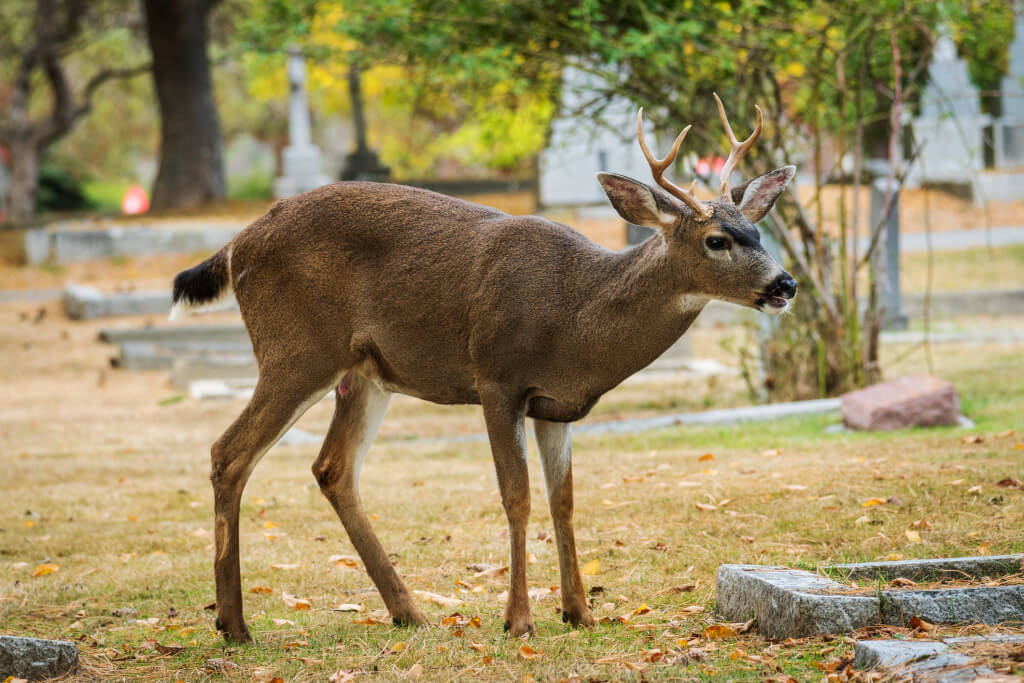'Zombie disease': incurable brain disease in deer can be transmitted to humans
A deer has been found dead in Yellowstone National Park and died from a highly contagious "zombie disease." A deadly brain disease could someday spread to humans, according to some scientists, reports FoxNews.

Photo: IStock
A deer carcass in the Wyoming park area tested positive for the highly contagious prion disease, CWD, according to the U.S. Centers for Disease Control and Prevention (CDC). It can also cause weight loss, stumbling, lethargy, and neurological symptoms. The disease has been seen in deer, elk, reindeer and moose in areas of North America, Canada, Norway and South Korea.
Deadly threat
Symptoms may take up to a year to develop. The disease is very dangerous - it is considered a type of mad cow disease. It causes changes in the brain and nervous system of the sick animal, causing it to become lethargic, powerless, and resemble a zombie with a characteristic “empty look.”
It is deadly and there is no known treatment or vaccine.
On the subject: Doctors have found out why Matthew Perry died: there were several reasons
And now scientists are sounding the alarm that CWD could spread to humans, although there have been no known cases.
Epidemiologists say the absence of a spillover case does not mean it won't happen. The disease is one of a group of fatal neurological disorders that includes bovine spongiform encephalopathy (BSE), commonly called "mad cow disease."
"The BSE outbreak in Britain was an example of how things can go wrong overnight when there is transmission from, say, livestock to people," said Dr Corey Anderson. Anderson is co-director of the Center for Infectious Disease Research and Policy (CIDRAP) program.
“We are talking about the possibility of something like this happening. No one is saying this is going to happen, but it’s important for people to be prepared,” Anderson added.
He added that it is also concerning that there is no known way to effectively and easily eradicate the disease “either from the animals that have it or from the environment that the disease pollutes.”
Once the environment is contaminated, the pathogen is extremely difficult to eradicate, Anderson said. It can persist for years in dirt or on surfaces. Scientists report that it is resistant to disinfectants, formaldehyde, radiation and burning at temperatures of 1100 F.
The CDC says on its website that some animal studies suggest the disease poses a risk to certain types of non-human primates, such as monkeys, that eat meat from infected animals or come into contact with the brain or body fluids of infected deer or elk.
“These studies raise concerns that there is a risk to people,” the CDC says on its website. “Since 1997, the World Health Organization has recommended that all known prion diseases be kept out of the human food chain.”
Tracking the situation
Park officials said the deadly brain disease has spread across Wyoming since the mid-1980s and is now found across much of the state. The disease is estimated to affect 10-15% of mule deer near Cody that migrate to southeast Yellowstone during the summer.
Last month, Yellowstone National Park said the disease's long-term impact on deer and elk in Yellowstone was unclear.
You may be interested in: top New York news, stories of our immigrants, and helpful tips about life in the Big Apple - read all this on ForumDaily New York.
The Public Wildlife Alliance estimated in 2017 that between 7 and 000 CWD-infected animals per year are unwittingly eaten by humans, a number expected to increase by 15% annually.
In 2005, researchers began monitoring 80 people who had mistakenly eaten contaminated meat and found that the group had "no significant changes in health."
However, as hunting season begins, the CDC recommends that hunters "strongly consider testing these animals before consuming the meat." The agency also recommends that hunters harvesting wild deer and elk in areas where CWD has been reported check the information to see if animal testing is recommended or required in that state or region.
Meanwhile, Yellowstone staff has increased collaboration and information sharing with the Wyoming Game and Fish Department and other state agencies to identify areas in Yellowstone at increased risk for CWD. Monitoring for the presence of CWD in deer and elk in the park has also been increased.
Read also on ForumDaily:
How to understand that a text on the Internet was written by AI and not a person
11 stupid expenses that prevent you from accumulating wealth: wealth strategy from Warren Buffett
Personal experience: 6 facts that surprised me while flying business class
Subscribe to ForumDaily on Google NewsDo you want more important and interesting news about life in the USA and immigration to America? — support us donate! Also subscribe to our page Facebook. Select the “Priority in display” option and read us first. Also, don't forget to subscribe to our РєР ° РЅР ° Р »РІ Telegram and Instagram- there is a lot of interesting things there. And join thousands of readers ForumDaily New York — there you will find a lot of interesting and positive information about life in the metropolis.












